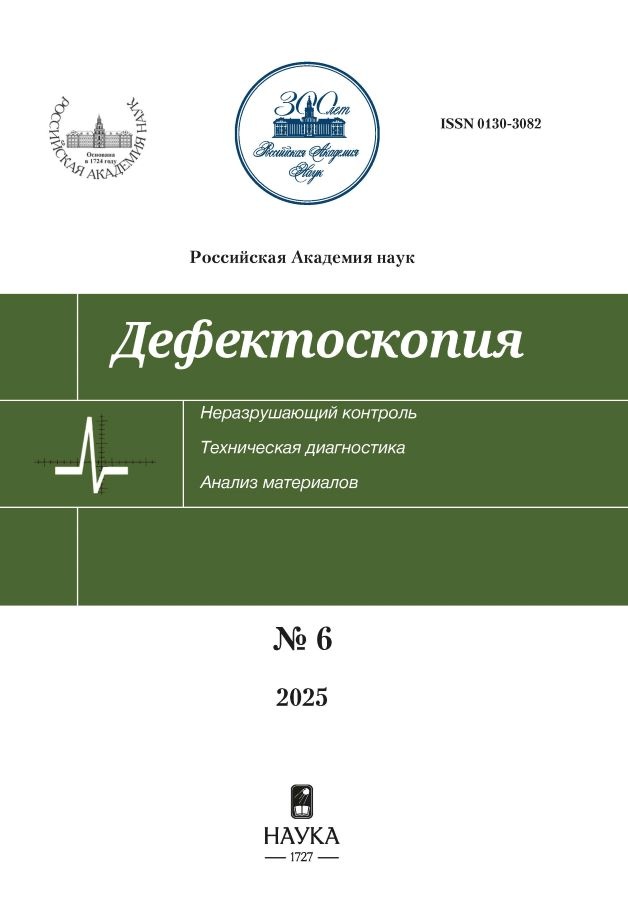Reflector type recognition using neural network based on TOFD echoes
- Авторлар: Bazulin E.G.1, Medvedev L.V.1
-
Мекемелер:
- ECHO+ Research and Production Center LLC
- Шығарылым: № 6 (2025)
- Беттер: 3-10
- Бөлім: Acoustic methods
- URL: https://clinpractice.ru/0130-3082/article/view/686466
- DOI: https://doi.org/10.31857/S0130308225060013
- ID: 686466
Дәйексөз келтіру
Аннотация
In this paper we propose to automate the classification of reflector types by TOFD-echoes using ResNet-18 convolutional neural network. The main focus is on modeling and classification of reflectors such as cracks, pores, non-welds and void areas. Experiments included training the model on TOFD echoes calculated both in a numerical experiment and TOFD echoes measured during ultrasonic inspection. The results showed high classification accuracy: 96,2 % in the numerical experiment, 97 % on experimentally measured TOFD-echoes with different types of reflectors. The study confirmed the possibility of using neural networks to determine the reflector type from TOFD-echo signals, which allows to automate the process of nondestructive testing and reduce the influence of human factor. For further development of the method it is suggested to use segmentation models for processing images with several reflectors.
Толық мәтін
Авторлар туралы
E. Bazulin
ECHO+ Research and Production Center LLC
Хат алмасуға жауапты Автор.
Email: bazulin@echoplus.ru
Ресей, 123458 Moscow, Tvardovskogo str., 8, Technopark «Strogino»
L. Medvedev
ECHO+ Research and Production Center LLC
Email: bazulin@echoplus.ru
Ресей, 123458 Moscow, Tvardovskogo str., 8, Technopark «Strogino»
Әдебиет тізімі
- Diffraction Time-of-Flight Method (TOFD). URL: https://ets-ndt.ru/azbuka/metod-tofd/ (accessed: ).
- Ginzel E. TOFD. Time-of-Flight Diffraction Ultrasonic Testing Method — Basic Principles and Practical Application Guide. Moscow: DPK Press, 2021. 311 p.
- Neural Network-Based Forecasting System in Industry. Habr. 2023. URL: https://habr.com/ru/articles/171019/ (accessed: ).
- Xu Joyce. Pattern Recognition Using Artificial Intelligence. Habr. 2023. URL: https://habr.com/ru/articles/709432/ (accessed: ).
- Petrova A.K. Application of Neural Networks for Optimizing the Gas Consumption Accounting Process // Proceedings of LETI (Saint Petersburg Electrotechnical University). 2015. No. 4. P. 53—60.
- Badalyan V.G., Vopilkin A.Kh. Application of Neural Networks in Ultrasonic Nondestructive Testing (Review) // Control. Diagnostics. 2023. No. 1. P. 12—25. URL: http://td-j.ru/index.php/current-issue-rus/2829-012-025 (accessed: ).
- Cantero-Chinchilla S., Wilcox P.D., Croxford A.J. A Deep Learning-Based Methodology for Artefact Identification and Suppression with Application to Ultrasonic Images // NDT & E International. 2022. V. 126. P. 102575. doi: 10.1016/j.ndteint.2021.102575. URL: https://www.sciencedirect.com/science/article/abs/pii/S0963869521001742 (accessed: ).
- ImageNet Large Scale Visual Recognition Challenge (ILSVRC). ImageNet. URL: https://image-net.org/challenges/LSVRC/index.php (accessed: ).
- Krysko N.V., Skrynnikov S.V., Shchipakov N.A. Classification and Sizing of Surface Pipeline Defects Based on Combined Diagnostics Using Ultrasonic, Eddy-Current, Visual and Measurement NDT Methods // Defectoskopiya. 2023. No. 12. P. 69—78.
- Sikora R. Artificial Neural Networks and Fuzzy Logic in Nondestructive Evaluation // Studies in Applied Electromagnetics and Mechanics. 2014. V. 38. P. 1—10.
- Dolmatov D.O. Application of Artificial Neural Networks in Acoustic Nondestructive Testing (Review) // Control. Diagnostics. 2022. No. 6. P. 44—50.
- Moddy2024/ResNet-18: Implemented the Deep Residual Learning for Image Recognition Paper and Achieved Better Accuracy by Customizing Different Parts of the Architecture. GitHub. URL: https://github.com/Moddy2024/ResNet-18?ysclid=lur45hjgt1921283081 (accessed: ).
- Deep Learning Toolbox — MATLAB. MathWorks. URL: https://www.mathworks.com/products/deep-learning.html (accessed: ).
- Official Website of EXTENDE. EXTENDE. URL: https://www.extende.com/ndt (accessed: ).
- API 1104: Welding of Pipelines and Related Facilities. American Petroleum Institute. Washington, DC, 1999. URL: https://archive.org/details/gov.law.api.1104.1999/page/n35/mode/2up (accessed: ).
- Official Website of “ECHO+”. URL: https://echoplus.ru/ (accessed: ).
Қосымша файлдар
















